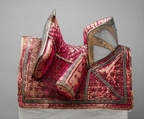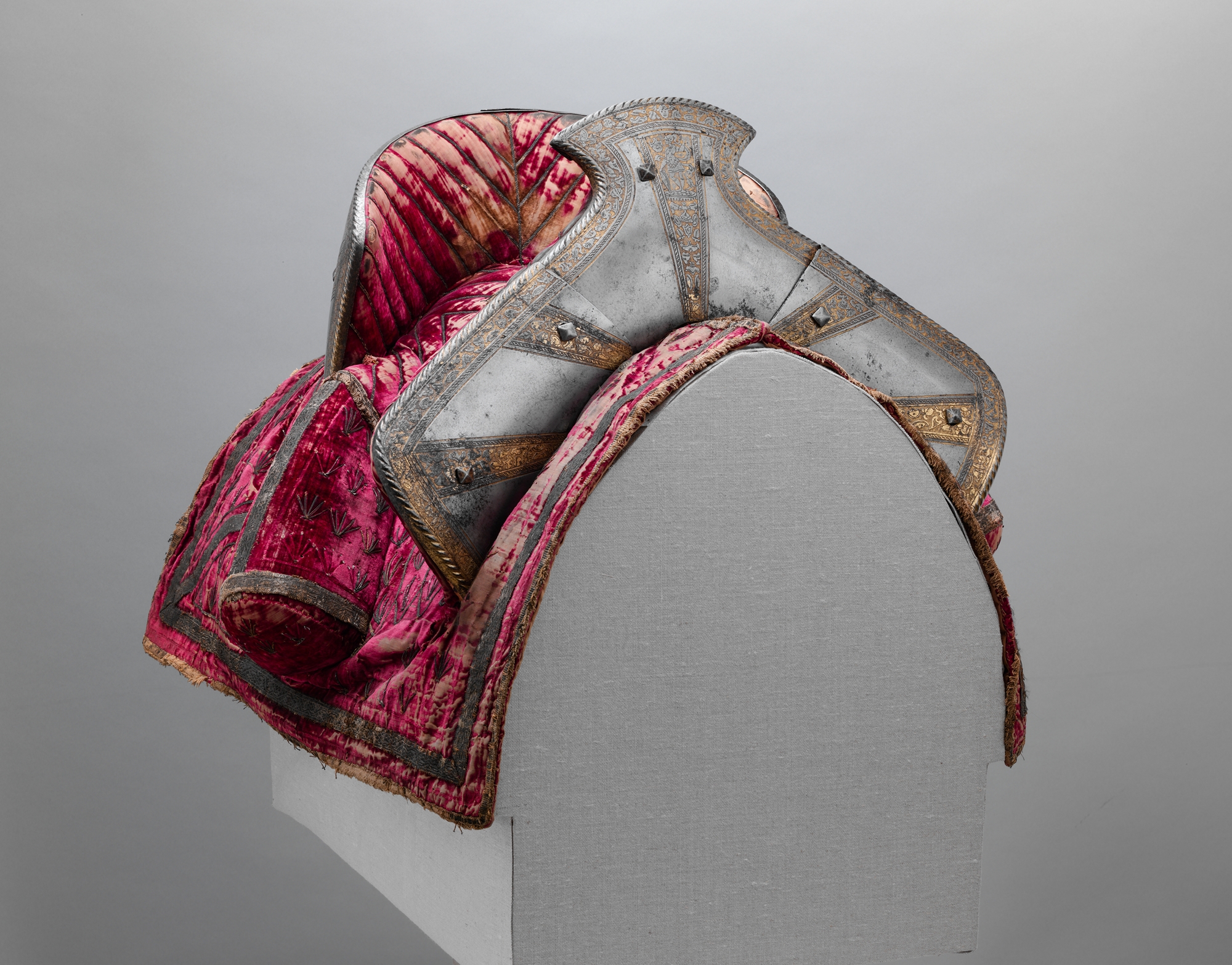Saddle
Not on view
This is an excellent example of a complete European war saddle of good quality from the mid- to late sixteenth century. The steels, padded saddle cover, and saddletree are original and all appear to belong together.
The saddletree is made up of both wooden and iron components. Its basic structure consists of a pommel and cantle of shaped wood, each of which is joined to a wooden base in the form of a semicircular arch, the arch being hidden under the saddle cover. The upper side of each arch is faced with leather, and the underside with canvas. The front and rear arches are connected by two horizontal sidebards, each made of a flat band of iron, the ends of which spread into a trefoil shape where they are nailed to the underside of the arches. The sidebards are slightly bowed inward to correspond to the curvature of a horse's back. Similar iron sidebars occur on the saddle from the armor garniture probably made for Henry VIII in 1527 (the so-called Genouilhac armor; acc. no. 19.131.2a). The outer surfaces of the wooden pommel and cantle (the areas covered by the saddle steels) are coated with a translucent layer of glue and fibers, probably composed of animal glue mixed with strands of sinew. This may have been intended to inhibit cracks in the wooden structure or to act as a moisture barrier between the steels and the underlying wood.
The saddle cover is made of red silk velvet that is enhanced with braided cord, woven trim, and woven fringe, and embroidered with a spray motif repeating in rows. The sprays are embroidered in silver and gilt-silver thread alternately by rows. The trim and fringe are also woven with alternate bands of silver and gilt-silver thread, all of which is now tarnished black. The area of the seat proper is quilted in a chevron pattern. The teardrop-shaped bolster on either side served as a cushion for the back of the rider's thigh. The form and decoration of the cover are also typical for saddles of this type. Although the cover is now faded and seriously worn, the brilliant color of the red velvet highlighted with glistening gilt-silver thread survives in a few small areas that have been protected beneath the saddle steels. With its etched, gilt, and brighly polished steels and vividly hued textile covering, the saddle in its original condition would have produced an effect of great richness.
The steels are of a form that was in wide use at the time. Of the three pommel plates, the center one is fan-shaped, with its edges overlapped by two symmetrical sideplates; the two broad, upright cantle plates wrap around the cantle but do not extend down the sides. The steels are attached by bolts with pyramidal heads, each of which screws into a corresponding threaded hole reinfoced by a threaded oblong iron washer inset into the wood. This was the standard method for the attachment of steels throughout the century. The steels have roped outer edges and are decorated with etched and gilt bands of trophies. The term trophies is used to describe a very popular form or ornament, which consists of stylized representations primarily of musical instruments, weapons, armor parts, and shields, but also of ribbons, cornucopias, urns, masks, and other objects. Adopted from the ornamental vocabulary of classical antiquity, groups of trophies reappeared in Italian architecture and decorative arts early in the Renaissance and as part of armor decoration by the late fifteenth century. By the 1550s they were the favored form of ornament for the etched decoration of Italian armor and remained so for the rest of the century.
An early and valuable record of this saddle is provided by a watercolored drawing made by the French artist Eugène Delacroix (1798–1863) during his visit to Samuel Meyrick's home in London in July 1825 (British Museum, 1975-3-1-35). Meyrick's renowned collection of arms and armor was a mecca for Romantic painters, including Delacroix and Richard Parkes Bonington (1802–1828), both of whom sketched details of armor and weapons for eventual use in their history paintings. When Delacroix drew the saddle, it was displayed on a horse with a German fluted armor of quite different style and date, an ensemble later illustrated in the catalogue of Meyrick's collection.
Due to rights restrictions, this image cannot be enlarged, viewed at full screen, or downloaded.
This artwork is meant to be viewed from right to left. Scroll left to view more.




